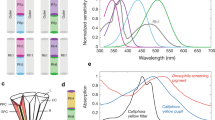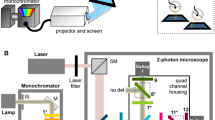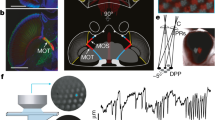Summary
The optical properties of the compound eye of Drosophila have been analysed using the optomotor reactions of flies with normal and mutant eye pigmentation. The stimulus was provided by cylindrical patterns with different periodic intensity distributions rotating at different speeds. The response consists of a torque about the vertical axis and was recorded under conditions of fixed flight. (Maximum reaction is about 0.04 dyn · cm). The transfer characteristics of the optical system are determined by the inter-ommatidial angle Δϕ, influencing the resolving power and by the width of the visual field of single ommatidia Δρ, influencing the response at high spatial frequencies. The values Δϕ = 4.6° and Δρ= 3.5° are obtained from stimulus-response experiments with Drosophila. They are independent of the presence of screening pigments. Differences in the response of flies with strong (+, se), weak (w a), and missing (w) pigmentation can be explained by the increased amount of scattered light in the pigment-deficient eyes. The overall intensities in the equally illuminated receptors are expected to be in the ratio 1∶1∶8∶25, respectively. The perception of motion depends only on the temporal, not on the spatial phase relations between periodic intensity variations in neighbouring ommatidia. Therefore the inhomogeneous distribution of the inter-ommatidial angle Δϕ changes the resolving power in different parts of the eye without changing the response to motion. Different simultaneous stimuli of equal strength in different parts of the eye are averaged in the perceptive system of Drosophila according to the number of ommatidia in these parts.
Similar content being viewed by others
Literatur
Autrum, H.: Die spektrale Empfindlichkeit der Augenmutation white-apricot von Calliphora. Biol. Zbl. 74, 515 (1955); - Die Sehschärfe pigmentfreier Facettenaugen von Calliphora erythrocephala. Biol. Zbl. 80, 1 (1961).
Barlow, H. B.: The size of ommatidia in apposition eyes. J. exp. Biol. 29, 667 (1952).
Demerec, M.: Biology of Drosophila. New York: John Wiley & Sons 1950.
Enoch, J. M.: Optical properties of the retinal receptors. J. opt. Soc. Amer. 53, 71 (1963).
Ephrussi, B.: Studies of eye pigments of Drosophila. Genetics 30, 71 (1945).
Exner, S.: Die Physiologie der facettierten Augen von Krebsen und Insekten. Leipzig: Franz Deuticke 1891.
Fermi, G., u. W. Reichardt: Optomotorische Reaktionen der Fliege Musca domestica. Kybernetik 2, 15 (1963).
Fernández-Morán, H.: Fine structure of the light receptors in the compound eye of insects. Exp. Cell Res., Suppl. 5, 586 (1958).
Fingerman, M.: The role of the eye-pigments of Drosophila melanogaster in photic orientation. J. exp. Zool. 120, 131 (1952).
Gaffron, M.: Untersuchungen über das Bewegungssehen bei Libellenlarven, Fliegen und Fischen. Z. vergl. Physiol. 20, 299 (1934).
Gavel, L. v.: Die „kritische Streifenbreite” als Maß der Sehschärfe bei Drosophila melanogaster. Z. vergl. Physiol. 27, 80 (1939).
Hassenstein, B.: Ommatidienraster und afferente Bewegungsintegration. Z. vergl. Physiol. 33, 301 (1951); - Über die Wahrnehmung von Figuren und unregelmäßigen Helligkeitsmustern. Z. vergl. Physiol. 40, 556 (1958a); - Die Stärke von optokinetischen Reaktionen auf verschiedene Mustergeschwindigkeiten. Z. Naturforsch. 13b, 1 (1958b); - Optokinetische Wirksamkeit bewegter periodischer Muster. (Nach Messungen am Rüsselkäfer Chlorophanus viridis). Z. Naturforsch. 14b, 659 (1959); - Hassenstein, B., u. W. Reichardt: Systemtheoretische Analyse der Zeit-, Reihenfolgen und Vorzeichenauswertung bei der Bewegungsperzeption des Rüsselkäfers Chlorophanus. Z. Naturforsch, 11b, 513 (1956).
Hecht, S., and G. Wald: The visual acuity and intensity discrimination of Drosophila. J. gen. Physiol. 17, 517 (1934).
Hertweck, H.: Anatomie und Variabilität des Nervensystems und der Sinnesorgane von Drosophila melanogaster. Z. wiss. Zool. 139, 559 (1931).
Hertz, M.: Zur Physiologie des Formen- und Bewegungssehens. Auflösungsvermögen des Bienenauges und Optomotorische Reaktion. Z. vergl. Physiol. 21, 579 (1935).
Johannsen, O. A.: Eye structure in normal and eye-mutant Drosophilas. J. Morphol. and Physiol. 39, 337 (1924).
Kalmus, H.: The optomotor responses of some eye mutants of Drosophila. J. Genet. 45, 206 (1943); - Optomotor responses in Drosophila und Musca. Physiol. comp. (śGrav.) 1, 127 (1949).
Kirschfeld, K., u. W. Reichardt: Die Verarbeitung stationärer optischer Nachrichten im Komplexauge von Limulus (Ommatidien-Sehfeld und räumliche Verteilung der Inhibition). Kybernetik 2, Heft 2 (1964).
Kühn, A.: Die Orientierung der Tiere im Raum. Jena: Gustav Fischer 1919.
Kuiper, J. W.: The optics of the compound eye. Symp. Soc. exp. Biol. 16, 58 (1962).
Kunze, P.: Untersuchung des Bewegungssehens fixiert fliegender Bienen. Z. vergl. Physiol. 44, 656 (1961).
Langer, H.: (In Vorbereitung.)
Mittelstaedt, H.: Zur Analyse physiologischer Regelungssysteme. Verh. dtsch. Zool. Ges. in Wilhelmshaven 8, 150 (1951).
Nolte, D. J.: The eye pigmentary system of Drosophila. J. Genet. 50, 79 (1950).
Power, M. E.: The brain of Drosophila melanogaster. J. Morph. 72, 517 (1943).
Reichardt, W.: Autokorrelations-Auswertung als Funktionsprinzip des Zentralnervensystems (bei der optischen Wahrnehmung eines Insekts). Z. Naturforsch. 12b, 448 (1957); - Nervous integration in the facet eye. Biophys. J. 2 (part 2), 121 (1961a); - Nervöse Verarbeitung optischer Nachrichten im Facettenauge. Jb. der Max-Planck-Gesellschaft S, 97 (1962).
Reichardt, W., u. D. Varjú: Übertragungseigenschaften im Auswertesystem für das Bewegungssehen (Folgerungen aus Experimenten an dem Rüsselkäfer Chlorophanus viridis). Z. Naturforsch. 14b, 674 (1959).
Varjú, D.: Optomotorische Reaktionen auf die Bewegung periodischer Helligkeitsmuster. (Anwendung der Systemtheorie auf Experimente am Rüsselkäfer Chlorophanus viridis.) Z. Naturforsch. 14b, 724 (1959).
Viscontini, M.: Ptérines et génétique chez drosophila melanogaster. Industr. Chim. Beige 10, 1181 (1960).
Waddington, C. H.: The ultra-structure of the developing eye of Drosophila. Proc. royal Soc. B. 153, 155 (1960).
Wald, G., and G. Allen: Fractionation of the eye pigments in Drosophila melanogaster. J. gen. Physiol. 30, 41 (1946).
Washizu, Y., and D. Burkhardt: Visual field of retinula cells. Z. vergl. Physiol. (im Druck).
Waterman, T. H.: Directional sensitivity of single ommatidia in the compound eye of Limulus. Proc. nat. Acad. Sci. (Wash.) 40, 252 (1954).
Wenking, H.: Unveröffentlicht.
Wolken, J. J.: Structure and molecular organization of retinal photoreceptors. J. opt. Soc. Amer. 53, 1 (1963).
Author information
Authors and Affiliations
Rights and permissions
About this article
Cite this article
Götz, K.G. Optomotorische Untersuchung des visuellen systems einiger Augenmutanten der Fruchtfliege Drosophila. Kybernetik 2, 77–92 (1964). https://doi.org/10.1007/BF00288561
Received:
Issue Date:
DOI: https://doi.org/10.1007/BF00288561




